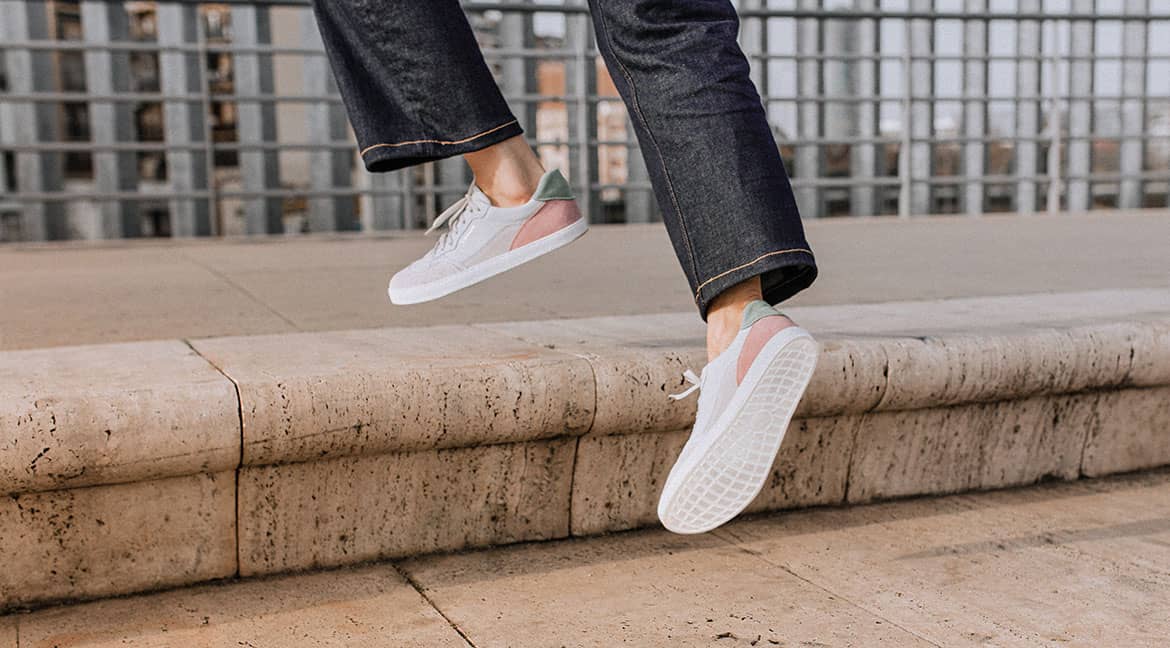Healthy feet thanks to barefoot walking: An insight into barefoot shoes
Walk healthy with Groundies barefoot shoes: Read here how barefoot walking affects your body and how you can integrate healthy walking into your everyday life.
Our feet are a masterpiece of evolution. We take an average of 160 million steps in the course of our lives. They remain stable thanks to 28 bones, 30 joints, 20 muscles and around 100 ligaments. They literally bear our entire body weight and carry it with flying colours. All the more reason to pay more attention to our feet and our foot health. We give you an insight into what you can do for healthy feet, which shoes are important for healthy walking and answer the question of whether walking barefoot is unhealthy or healthy.
Healthy walking, healthy feet
When we walk normally and healthily, the load takes place mainly in the midfoot. This means that the foot is placed on the heel and then rolled over the entire foot to the toes. The foot should always be placed gently and smoothly in the middle heel area rather than hard and stiff. In our fast-moving times, healthy walking is undoubtedly also a question of practice and above all requires a certain amount of mindfulness in everyday life. However, mindful walking is an important basis for permanently healthy feet. To prevent foot problems, our feet need not only attention and exercise, but also care and relief.
Healthy feet need attention
Be aware of your feet. How do they feel? Warm, cold, dry, rough, moist? Can you move your toes loosely, let your ankles circle? What does the skin of your feet look like? Rosy or pale? Our feet are a masterpiece of evolution, yet they rarely get any attention. Take some time to notice your feet in peace and quiet. Feel how it feels when your feet are allowed to walk barefoot and unrestricted.The right care for healthy feet
Healthy feet need regular care. That means a soothing foot bath, careful removal of calluses. Especially in autumn and winter, our feet suffer from dryness, which is why they deserve an extra portion of moisture right now. Well-groomed feet also have a health benefit. For example, healthy feet can defend themselves better against fungal spores than dry feet. "Dress code": In the office, in the supermarket, when going to the authorities - in some places it is somewhat difficult or simply not allowed to walk barefoot.Feet want to keep on moving
It is essential for our foot health that our feet keep moving. Whether you regularly go for a walk, walk or jog or simply strengthen your feet with targeted foot exercises - healthy feet are mobile feet. This also trains your foot condition. The more your feet are used to being in motion, the less they tire on strenuous days and the faster they recover.Relieve feet properly
Our feet bear our entire body weight and are thus able to withstand quite a lot. Even more - in the course of their lives, our feet literally kick themselves flat. Overstrained feet also create other health problems in the body over time. Once the body's statics are impaired, this also becomes noticeable in the knees, hips and back. It is therefore all the more important that we elevate our feet as often as possible. Especially on days when we walk or stand a lot.
Foot Health - Exercises for Healthy Feet
In order for our feet to remain healthy and mobile in the long term, they need regular exercise. A strong foot musculature is particularly important. They support the body's balance and help to prevent deformities. Five minutes of foot yoga a day is all it takes, and it can be easily integrated into everyday life.
- Grasping objects barefoot - exercise for strengthened foot muscles Sit barefoot and straight on a chair and first feel the floor under your feet. Then try to grasp different objects with your toes and lift them up. This can be a marble, a pen or a paper tissue. In between, spread your toes, tighten them or curl them up. Consciously moving and mobilising your toes helps you to strengthen your foot muscles.
- Barefoot stair walking - exercise for a strengthened ankle joint If you want to train your ankle, you should run up and down stairs barefoot or climb ladders barefoot. Admittedly, this exercise requires some practice, but it pays off. Besides strengthening the ankle, it also stretches the shin and calf muscles.
Barefoot walking - unhealthy or healthy pleasure?
At the latest since the trend towards barefoot shoes, barefoot walking has again become more of a focus for foot health. From barefoot sneakers for men, barefoot sandals to barefoot outdoor boots almost every type of shoe is now available in a barefoot version. But is barefoot walking unhealthy or a healthy pleasure? Our barefoot experts clearly say "healthy". The fact that barefoot running is healthy already lies in the origin of our body statics. Barefoot walking is the most primal way of walking and it is precisely barefoot walking on different surfaces that activates our senses, sensorimotor functions and mobilises our feet. By placing our feet flat on the ground, our body also straightens up. When walking barefoot, our toes also have enough space to spread out in all directions. Barfußlaufen ist daher nicht nur eine gratis Fußreflexzonenmassage sondern hilft unserem Körper auch, wieder mehr in Balance zu kommen. Barefoot walking is therefore not only a free foot reflexology massage but also helps our body to regain its balance. Healthy feet also love variety: Ideally, you should walk on different surfaces, for example barefoot through the grass, over sand or a soft forest floor.
Healthy feet through barefoot shoes
As healthy as natural barefoot walking is, it is not always possible to walk barefoot at work or in your free time. Barefoot shoes are therefore a healthy way to move as naturally as possible. There are three main advantages that distinguish Groundies barefoot shoes from conventional shoes:
- Zero Drop
Barefoot shoes from Groundies have no offset, which means that the heel and forefoot are flat on the ground. Walking and standing flat supports the natural body statics and is the healthiest form of movement. In addition, less stress is placed on the forefoot, as the greater part of the body's weight rests on the heel. - Thin sole
The Groundies mini sole is thin and flexible, which promotes the mobility of the foot. It also helps to build up the foot muscles by making the foot work itself. Shoes for healthy feet: The almost direct contact with the ground creates a better body feeling and supports anatomically sensible foot coordination. - Wide toe box Groundies barefoot shoes have a wide toe box, which allows your toes to spread out and coordinate better. Because your toes can separate better, they are also evenly and powerfully active. Especially the big toe, which is cramped in conventional shoes, now has room to straighten out again.
The miracle of healthy feet - did you know?
- In the course of our lives, we take around 160 million steps.
- Stable ground: 28 bones, 30 joints, 20 muscles and around 100 ligaments hold our feet together
- Heeled shoes reduce the all-important footprint of our feet, shifting weight towards the forefoot. In the long run, this can lead to pain, exhaustion, balance problems and altered body statics.
- The health of our feet has a significant impact on our entire body. Changes in foot health over time can be felt through the knees, hips, back and even the head
- Feet love breathable material. Here, leather is a natural product that is still superior in its properties to many synthetic materials. Breathable microfibre also ensures a good foot climate in healthy shoes.
















